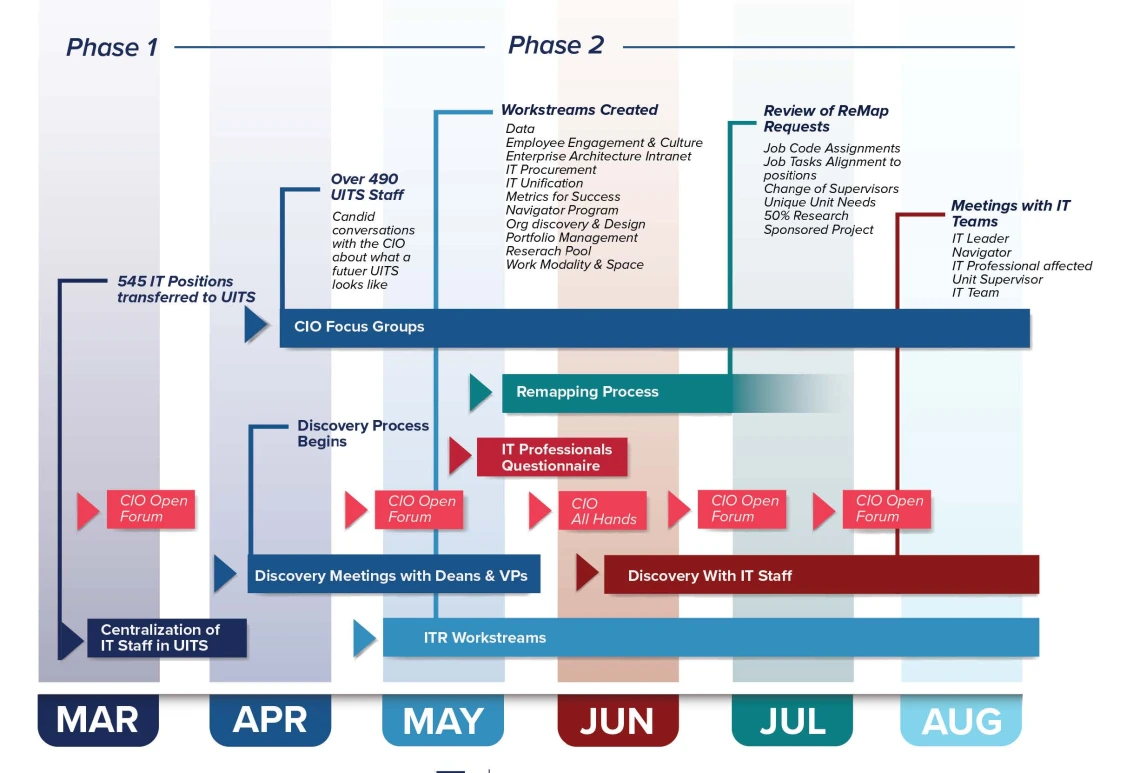RESTRUCTURE OF INFORMATION TECHNOLOGIES
The Centralization Journey
As part of the University’s financial action plan, it was announced in late January 2024 that information technology staff positions across the institution would be centralized into the University Information Technology Services (UITS) division. The centralization of IT services would lead to cost savings, greater operational efficiencies and stronger information security practices across the institution.
Since then, the effort moved from complete centralization into a discovery and planning process about how best to restructure the university’s IT services and staff. In addition to meeting the initial goals of university leadership, UITS leaders focused on the best organizational design to meet the campus community’s growing needs.
CENTRALIZATION TO RESTRUCTURE
The IT Restructure (ITR) effort, which was led by Lanita Collette, Susan Legg, Michael Medina and Darcy Van Patten, worked diligently to identify and define the roles of over 600 IT staff supporting colleges and departments. This effort involved a comprehensive discovery process, conducted on multiple levels, to gain a deeper understanding of the IT work being performed by the IT workforce. This was a challenging task for all involved and UITS leaders were committed to approaching this work thoughtfully and with empathy. It was and continues to be crucial to thoroughly understand the activities and the people involved in supporting IT operations across the university. UITS was dedicated to ensuring continuity in technology support for research, instruction, and business activities during the restructuring process that continued into 2025. Subject-specific workstreams ensured that the many areas of the ITR initiative stayed on task and within timelines to achieve goals.
Organizational Discovery
Recognizing that some IT positions might not fit into an individual’s current job code and description, an opportunity was given for individual staff and supervisors to request a special review and potential remapping of positions that were borderline IT or falling within another job family. This remapping request opportunity took place in late March 2024 before the discovery process commenced.
The first stage of the individual discovery process began in April with meetings including ITR leaders with Deans or Vice Presidents who would be impacted by the restructure. These high-level meetings continued into June.
In late May, an IT Professional Questionnaire was published for all those who were affected by the shift into UITS so they could detail what tasks they perform most often as related to their job code, and whether their actual tasks align to their position.
IT job tasks in smaller units often strayed beyond job titles and position description. The questionnaire helped to clarify the job tasks and IT positions in practice by individual IT professionals.
Questionnaire responses were collected, and the information was used to identify the IT environment before setting individual discovery meetings with IT leadership. Step two of discovery was individual discovery meetings with the IT professional, ITR leaders, and their previous unit’s navigator. These meetings continued into September with great care taken to fully develop and maintain a high level of engagement with the IT professional affected, that person’s previous unit supervisor and the unit’s team as well as their previous unit’s leadership.
FOCUS GROUPS
As the restructure evolved, a CIO listening tour was facilitated by Barry Brummund, CIO of the University of Arizona. Each UITS employee received an invitation to participate in a focus group.
The focus group setting aimed to give voice to employees to share their ideas, concerns, expectations and hopes for what the new UITS organization would look like. The focus group process lasted four months, from late April to August. During these group meetings, 2,070 unique comments were collected.
Prior to the March 4 centralization, the university’s information technology was organized as a large central organization (UITS), and then there were many other small- to medium-sized IT organizations. Each IT organization was different, ultimately leading to divergent perspectives for individuals in each organization. The CIO focus groups were established to gain insight into the experiences and perspectives of the entire university IT organization.
Barry Brummund, explains, “It’s easy to get sidetracked and listen to just the loudest voices. And I really didn’t want to hear from just the loudest voices or have only the top of the organizational hierarchy drive the conversation on establishing our culture and what we as a division want to be.”
The question posed in all focus groups was the same: “What do you want UITS to be?” The responses were recorded anonymously and later synthesized into themes that would become guiding principles to help shape UITS identity, culture, and decision-making. The group structure allowed a small group setting to create safe and open spaces for good discussion, not only with the CIO but also among colleagues in the room.
Tremendous insight was gathered from these focus groups.
One factor that became most visible for Brummund is that the university has the talent to do anything. “Determining how the new UITS is organized, how we work with one another, our processes, how we work with campus colleagues, how we prioritize things, and what technologies we use is a big next step.”
UITS has a lot of talent, experience, and rich diversity that can be leveraged to undertake incredibly complex changes quickly and durably over a long period of time. The focus group journey allowed executive leaders to update that context from across the university and tap into the strengths of all the employees who joined the organization on March 4 as well.
Brummund explained, “There is a lot to do to put the structure in place for UITS to be able to tap into the diversity that we have. But we truly have the ability, we have the talent to do anything from an information technology perspective, which is very exciting.”
64 Unique Focus Groups
493 Focus Group Attendees

